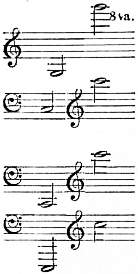Concertina
 From Britannica 11th Edition (1911)
From Britannica 11th Edition (1911) Concertina, or Melodion (Fr. concertina, Ger. Ziehharmonica or Bandoneon), a wind instrument of the seraphine family with free reeds, forming a link in the evolution of the harmonium from the mouth organ, intermediate links being the cheng and the accordion. The concertina consists of two hexagonal or rectangular keyboards connected by a long expansible bellows of many folds similar to that of the accordion. The keyboards are furnished with rows of knobs, which, on being pressed down by the fingers, open valves admitting the air compressed by the bellows to the free reeds, which are thus set in vibration. These free reeds consist of narrow tongues of brass riveted by one end to the inside surface of the keyboard, and having their free ends slightly bent, some outwards, some inwards, the former actuated by suction when the bellows are expanded, the latter by compression. The pitch of the note depends upon the length and thickness of the reeds, reduction of the length tending to sharpen the pitch of the note, while reduction of the thickness lowers it. The bellows being unprovided with a valve can only draw in and emit the air through the reed valves. In order to produce the sound, the concertina is held horizontally between the hands, the bellows being by turns compressed and expanded. The English concertina, invented and patented by Sir Charles Wheatstone in 1829, the year of the reputed invention of the accordion (q.v.), is constructed with a double action, the same note being produced on compressing and expanding the bellows, whereas in the German concertina or accordion two different notes are given out. Concertinas are made in complete families—treble, tenor, bass and double bass, having a combined total range of nearly seven octaves. The compass is as follows:—

Treble concertina, double action
Tenor concertina, single action
Bass concertina, single action
Double bass concertina, single action
The timbre of the concertina is penetrating but soft, and capable of the most delicate gradations of tone. This quality is due to a law of acoustics governing the vibration of free reeds by means of which fortes and pianos are obtained by varying the pressure of the wind, as is also the case with the double reed or the single or beating reed, while the pressure of the reed with the lips combined with greater pressure of wind produces the harmonic overtones which are not given out by free reeds. The English concertina possesses one peculiarity which renders it unsuitable for playing with instruments tuned according to the law of equal temperament, such as the pianoforte, harmonium or melodion, i.e. it has enharmonic intervals between G♯ and A♯ and between D♭ and E♭. The German concertina is not constructed according to this system; its compass extends down to C or even B♭, but it is not provided with double action. It is possible on the English concertina to play diatonic and chromatic passages or arpeggios in legato or staccato style with rapidity, shakes single and double in thirds; it is also possible to play in parts as on the pianoforte or organ and to produce very rich chords. Concertos were written for concertina with orchestra by Molique and Regondi, a sonata with piano by Molique, while Tschaikowsky scored in his second orchestral suite for four accordions.
The aeola, constructed by the representatives of the original firm of Wheatstone, is a still more artistically developed concertina, having among other improvements steel reeds instead of brass, which increase the purity and delicacy of the timbre.
See also Accordion; Cheng; Harmonium; Free-Reed Vibrator.
↧ Download as ZWI file | Last modified: 11/17/2022 15:24:09 | 11 views
☰ Source: https://oldpedia.org/article/britannica11/Concertina | License: Public domain in the USA. Project Gutenberg License
 ZWI signed:
ZWI signed: KSF
KSF